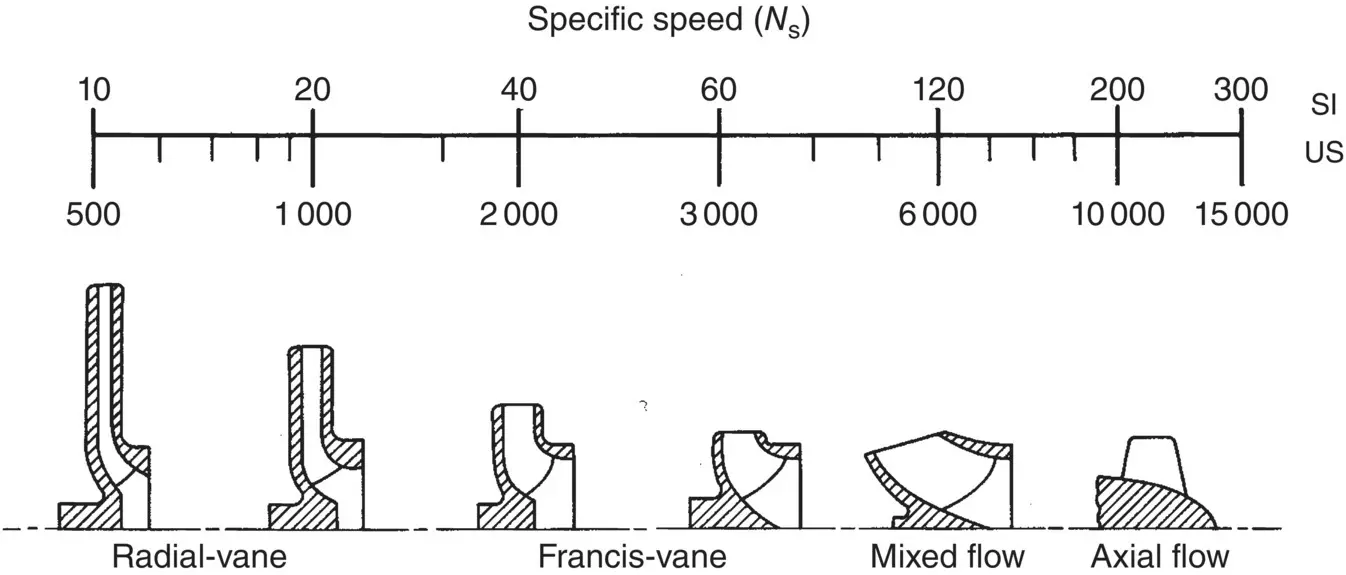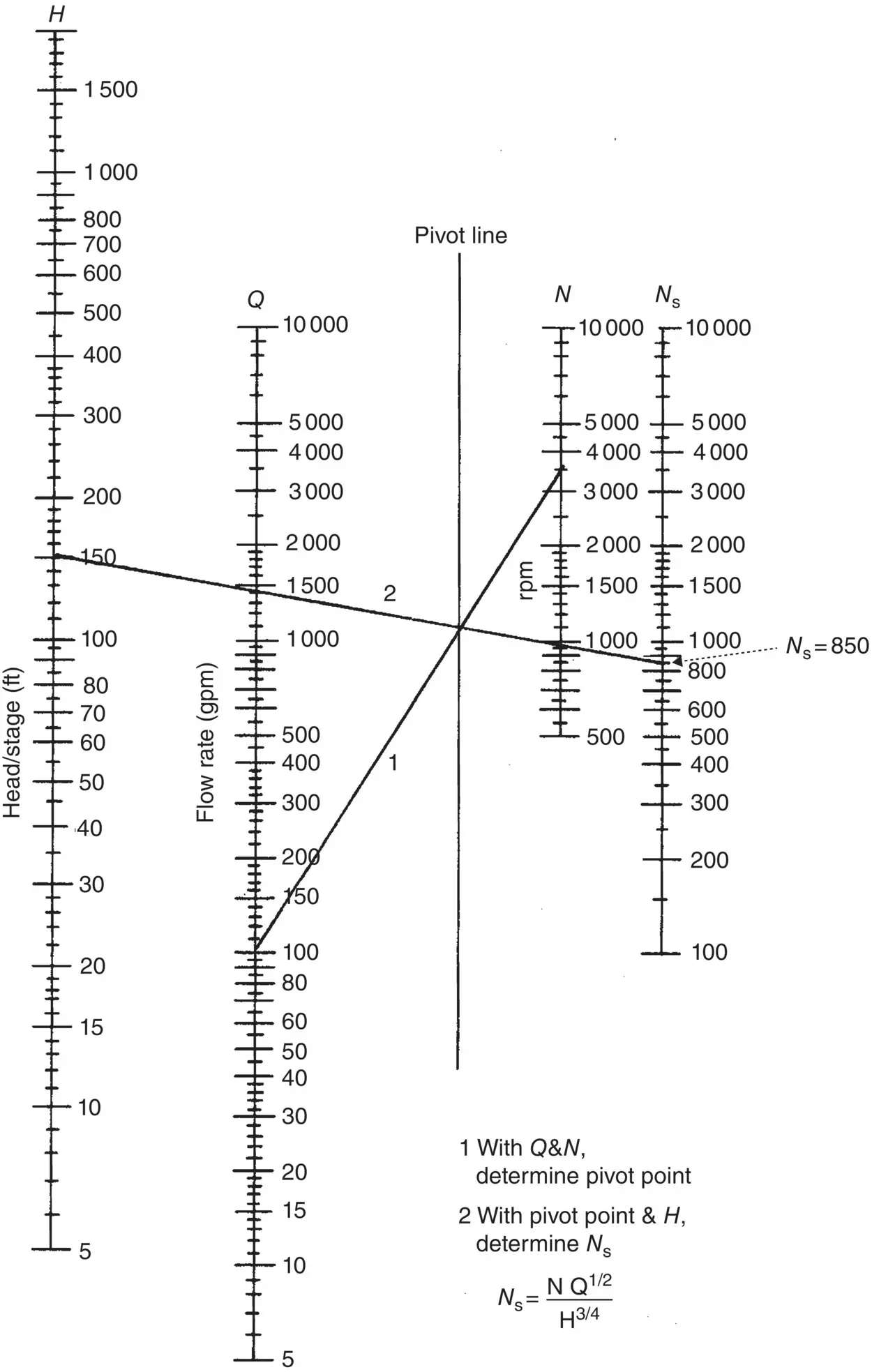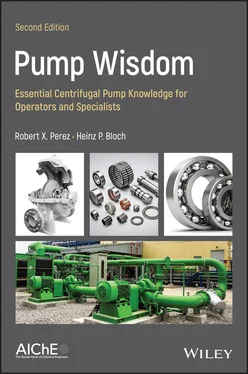Regardless of flow classification centrifugal pumps range in size from tiny pumps to very big pumps. The tiny ones might be used in medical or laboratory applications; the extremely large pumps may move many thousands of liters or even gallons per second from flooded lowlands to the open sea.
All six of the impellers in Figure 1.5are shown with a hub fastening the impeller to the shaft, and each of the first five impellers is shown as a hub‐and‐disc version with an impeller cover. The cover (or “shroud”) identifies the first five as “closed” impellers; recall that Figure 1.3had depicted a semiopen impeller. Semiopen impellers are designed and fabricated without the cover. Finally, open impellers come with free‐standing vanes welded to or integrally cast into the hub. Since the latter incorporate neither disc nor cover, they are often used in viscous or fibrous paper stock applications.
To properly function, a semiopen impeller must operate in close proximity to a casing internal surface, which is why axial adjustment features are needed with these impellers. Axial location is a bit less critical with closed impellers. Except on axial flow pumps, fluid exits the impeller in the radial direction. Radial and mixed flow pumps are either single or double suction designs; both will be shown later. Once the impellers are fastened to a shaft, the resulting assembly is called a rotor.
In radial and mixed flow pumps, the number of impellers following each other, typically called “stages,” can range from one to as many as will make such multistage pumps practical and economical to manufacture. Horizontal shaft pumps with up to 12 stages are not uncommon; using more than 12 stages on a horizontal shaft risks causing the rotor to resonate or vibrate at a so‐called “critical speed.” Vertical shaft pumps have been designed with 48 or more stages. In vertical pumps, shaft support bushings are relatively lightly loaded; they are spaced so as to minimize vibration risk.

Figure 1.5 General flow classifications of process pump impellers.
The Meaning of Specific Speed
Pump impeller flow classifications and the general meaning of specific speed deserve further discussion. Moving from left to right in Figure 1.5, the various impeller geometries reflect selections that start with high differential pressure capabilities and end with progressively lower differential pressure capabilities. Differential pressure is simply discharge pressure minus suction pressure.
Specific speed calculations are a function of several impeller parameters; the mathematical expression includes exponents and is found later, in Figure 1.6. Staying with Figure 1.5and again moving from left to right, we can reason that larger throughputs (flows) are more likely achieved by the configurations at right, whereas larger pressure ratios (discharge pressure divided by suction pressure) are usually achieved by the impeller geometries closer to the left of the illustration.
Impellers toward the right are more efficient than those near the left, and pump designers use the parameter specific speed ( N s) to bracket pump hydraulic efficiency attainment and other expected attributes of a particular impeller configurations and size. Please be sure not to confuse a very similar sounding parameter, pump suction specific speed ( N ssor N sss), with the specific speed ( N s). For now, we are strictly addressing specific speed ( N s).
As an example, observe the customary use, whereby with N and Q – the typical given parameters that define centrifugal process pumps – one determines a pivot point. Next, with pivot point and head H , one can easily determine N s. In Figure 1.5, N s is somewhere between 500 and 15 000 on the US scale. Whenever we find ourselves in that range, we know such a pump exists, and we can even observe the general impeller shape. Keep in mind that thousands of impeller combinations and geometries exist. Impellers with covers are the most prominent in hydrocarbon processes, and an uneven number of impeller vanes is favored over even numbers of vanes for reasons of vibration suppression.
Pump specific speed, Figure 1.6, might be of primary interest to pump designers, but average users will also find it useful. On the lower right, the illustration gives the equation for N s; it will be easy to see how N sis related to the shaft speed N (rpm), flow Q (gpm or gallons/minute), and head H (expressed in feet). This mathematical expression also has two strange‐looking exponents in it, but the N snomogram conveys more than meets the eye and can be quite helpful.
If now, we had the same or some other Q and would want to see what happens at some other speed, we would again draw a straight line to establish the pivot point. Drawing a line from whatever H is specified through the pivot point and to N swe would not like to select pumps with an N soutside the rule‐of‐thumb range from 500 to 15 000. In another example, we might, after establishing the pivot point, wish to determine what happens if we select an impeller with the maximum head capability of 700 ft and draw a line through the pivot point. If the resulting N sis too low, we would try a higher speed N and see what happens.

Figure 1.6 Pump specific speed nomogram allowing quick estimations. Shown in this illustration is a hypothetical pump application with a flow of 100 gpm operating at 3600 rpm (line 1). To develop 150 ft of head with a single stage, an impeller with a specific speed of 850 (line 2) would be required.
While there are always fringe applications in terms of size and flow rate, this book deals with centrifugal pumps in process plants. These pumps are related to the generic illustrations of Figures 1.1and 1.2and others in this chapter. All would somewhat typically – but by no means exclusively – range from 3 to perhaps 300 hp (2–225 kW).
The elementary process pumps illustrated in Figures 1.1and 1.2probably incorporate one of the radial vane impellers shown in Figure 1.5. If a certain differential pressure is to be achieved together with higher flows, such a pump is often designed with a double‐flow impeller ( Figure 1.7). One of the side benefits of double‐flow impellers is very good axial thrust equalization (axial balance). A small thrust bearing will often suffice; it is shown here in the left bearing housing. Note that the two radial bearings are plain, or sleeve‐type. Certain sleeve bearings have relatively high speed capability.

Figure 1.7 Double‐flow impellers are used for higher flows and relatively equalized (balanced) axial thrust.
Source: Mitsubishi Heavy Industries, Ltd. [4].
If elevated pressures are needed, several impellers are lined up in series on the same pump rotor. Of course, this would then turn the pump into a multistage model Figure 1.8.
Process Pump Mechanical Response to Flow Changes
Читать дальше












